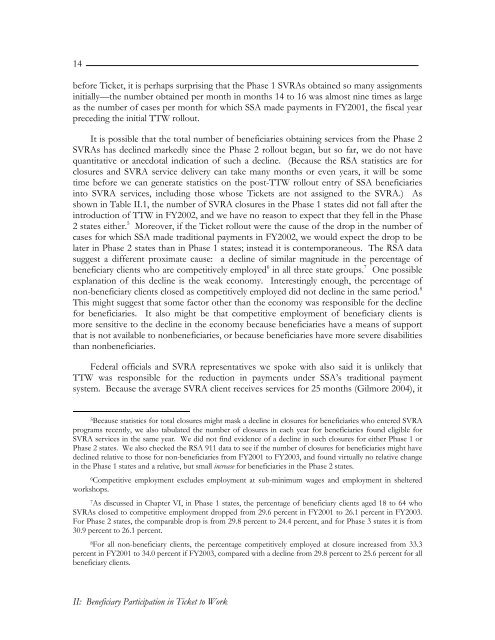Evaluation of the Ticket to Work Program, Implementation ...
Evaluation of the Ticket to Work Program, Implementation ...
Evaluation of the Ticket to Work Program, Implementation ...
You also want an ePaper? Increase the reach of your titles
YUMPU automatically turns print PDFs into web optimized ePapers that Google loves.
14before <strong>Ticket</strong>, it is perhaps surprising that <strong>the</strong> Phase 1 SVRAs obtained so many assignmentsinitially—<strong>the</strong> number obtained per month in months 14 <strong>to</strong> 16 was almost nine times as largeas <strong>the</strong> number <strong>of</strong> cases per month for which SSA made payments in FY2001, <strong>the</strong> fiscal yearpreceding <strong>the</strong> initial TTW rollout.It is possible that <strong>the</strong> <strong>to</strong>tal number <strong>of</strong> beneficiaries obtaining services from <strong>the</strong> Phase 2SVRAs has declined markedly since <strong>the</strong> Phase 2 rollout began, but so far, we do not havequantitative or anecdotal indication <strong>of</strong> such a decline. (Because <strong>the</strong> RSA statistics are forclosures and SVRA service delivery can take many months or even years, it will be sometime before we can generate statistics on <strong>the</strong> post-TTW rollout entry <strong>of</strong> SSA beneficiariesin<strong>to</strong> SVRA services, including those whose <strong>Ticket</strong>s are not assigned <strong>to</strong> <strong>the</strong> SVRA.) Asshown in Table II.1, <strong>the</strong> number <strong>of</strong> SVRA closures in <strong>the</strong> Phase 1 states did not fall after <strong>the</strong>introduction <strong>of</strong> TTW in FY2002, and we have no reason <strong>to</strong> expect that <strong>the</strong>y fell in <strong>the</strong> Phase2 states ei<strong>the</strong>r. 5 Moreover, if <strong>the</strong> <strong>Ticket</strong> rollout were <strong>the</strong> cause <strong>of</strong> <strong>the</strong> drop in <strong>the</strong> number <strong>of</strong>cases for which SSA made traditional payments in FY2002, we would expect <strong>the</strong> drop <strong>to</strong> belater in Phase 2 states than in Phase 1 states; instead it is contemporaneous. The RSA datasuggest a different proximate cause: a decline <strong>of</strong> similar magnitude in <strong>the</strong> percentage <strong>of</strong>beneficiary clients who are competitively employed 6 in all three state groups. 7 One possibleexplanation <strong>of</strong> this decline is <strong>the</strong> weak economy. Interestingly enough, <strong>the</strong> percentage <strong>of</strong>non-beneficiary clients closed as competitively employed did not decline in <strong>the</strong> same period. 8This might suggest that some fac<strong>to</strong>r o<strong>the</strong>r than <strong>the</strong> economy was responsible for <strong>the</strong> declinefor beneficiaries. It also might be that competitive employment <strong>of</strong> beneficiary clients ismore sensitive <strong>to</strong> <strong>the</strong> decline in <strong>the</strong> economy because beneficiaries have a means <strong>of</strong> supportthat is not available <strong>to</strong> nonbeneficiaries, or because beneficiaries have more severe disabilitiesthan nonbeneficiaries.Federal <strong>of</strong>ficials and SVRA representatives we spoke with also said it is unlikely thatTTW was responsible for <strong>the</strong> reduction in payments under SSA’s traditional paymentsystem. Because <strong>the</strong> average SVRA client receives services for 25 months (Gilmore 2004), it5 Because statistics for <strong>to</strong>tal closures might mask a decline in closures for beneficiaries who entered SVRAprograms recently, we also tabulated <strong>the</strong> number <strong>of</strong> closures in each year for beneficiaries found eligible forSVRA services in <strong>the</strong> same year. We did not find evidence <strong>of</strong> a decline in such closures for ei<strong>the</strong>r Phase 1 orPhase 2 states. We also checked <strong>the</strong> RSA 911 data <strong>to</strong> see if <strong>the</strong> number <strong>of</strong> closures for beneficiaries might havedeclined relative <strong>to</strong> those for non-beneficiaries from FY2001 <strong>to</strong> FY2003, and found virtually no relative changein <strong>the</strong> Phase 1 states and a relative, but small increase for beneficiaries in <strong>the</strong> Phase 2 states.6 Competitive employment excludes employment at sub-minimum wages and employment in shelteredworkshops.7 As discussed in Chapter VI, in Phase 1 states, <strong>the</strong> percentage <strong>of</strong> beneficiary clients aged 18 <strong>to</strong> 64 whoSVRAs closed <strong>to</strong> competitive employment dropped from 29.6 percent in FY2001 <strong>to</strong> 26.1 percent in FY2003.For Phase 2 states, <strong>the</strong> comparable drop is from 29.8 percent <strong>to</strong> 24.4 percent, and for Phase 3 states it is from30.9 percent <strong>to</strong> 26.1 percent.8 For all non-beneficiary clients, <strong>the</strong> percentage competitively employed at closure increased from 33.3percent in FY2001 <strong>to</strong> 34.0 percent if FY2003, compared with a decline from 29.8 percent <strong>to</strong> 25.6 percent for allbeneficiary clients.II: Beneficiary Participation in <strong>Ticket</strong> <strong>to</strong> <strong>Work</strong>
















